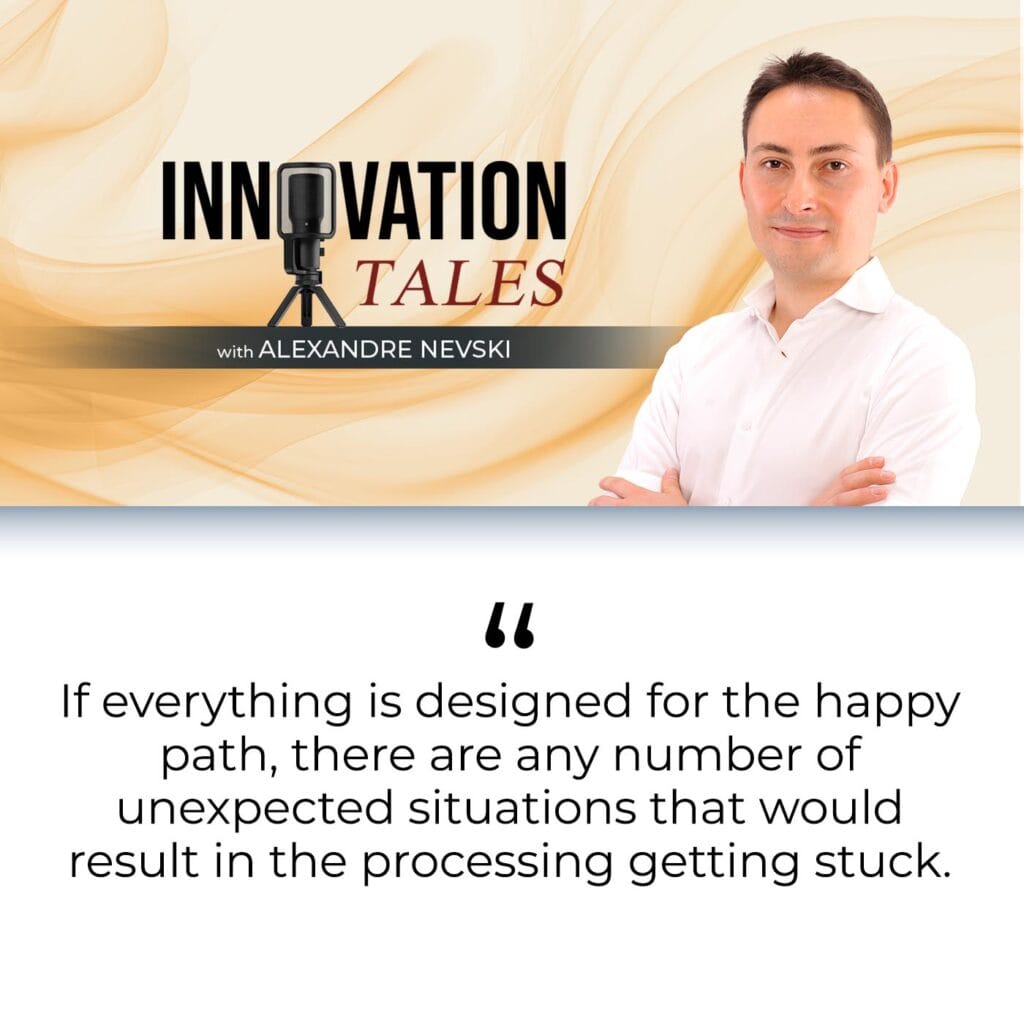
From Post-Its® To AI: The Value Of Flexibility
Struggling to balance automation with the need for flexibility? In this episode of Innovation Tales, host Alexandre Nevski shares a story from his own experience, highlighting how dynamic case management technology gave one organization the best of both worlds. By focusing on real-time collaboration and data-driven insights, they improved customer service while gathering critical information for process optimization and AI deployment. Get insights and practical advice for your own digital transformation initiative!
Pega® is a trademark of Pegasystems Inc. Please visit https://www.pega.com to learn more.
Post-it is a registered trademark of 3M.
Transcript
Post-its have a great many uses. In a business context, they can be used to decorate with random bits of information the actual tools we use to process information from computers. One of the ways that Post-its are awesome is their flexibility. There are no rules that govern which color must be used in a particular situation. You cannot get stuck in a Post-it if you write your note in the incorrect format. What do Post-it notes have to do with AI, you ask? In this episode, we’ll consider how the design of business applications should always start with flexibility because that lays a foundation for your digital transformation, including the deployment of AI.
A few years ago, I got the chance to visit a call center and observe agents interact with customers on the phone. I was there to do what’s called an Operational Walkthrough. I was there to look for opportunities to improve the user and customer experience. As I sat down to listen to a conversation, I noticed the agent prepared a block of Post-its. They were following a script that was being provided by an application on their desktop but every now and then, they would note the response from the customer on a Post-it. After the conversation, they took a couple of minutes to transfer their notes before making themselves available again for the next call during which they used the Post-its again.
Have you had similar experiences? What words would you use to describe the average business application? Would you say it is intuitive and comfortable to use? The good ones are. How many are too rigid to support user needs? How many force them into the workarounds I observed in that call center? In your opinion, what is the difference between a rigid and a flexible application?
‐‐‐
Echoes Of Innovation
I would like to tell you the story of a large organization I supported some time ago. They provided a diverse set of financial services to private individuals and needed to defend their market position from new entrants offering better customer service. To protect the innocent, let’s call the large organization, Old Stone Bank, and the person in charge of its customer service, Sam.
Sam knew the organization had to improve resolution times, resolution rates, and transparency. She also knew this wasn’t going to be easy. Customer advisors weren’t lazy. They were pretty good at their job but there was so much complexity. There were dozens of teams, and almost as many systems. The rule book that employees had to follow to keep the regulator happy waited for the proverbial ton.
What’s more, Sam could not tell her staff to stop taking calls, to put down their pencils, to close down shop while they were improving their systems and processes. The organization needed to do that on the fly. A little bit like in the story of the ship of Theseus. For those unfamiliar with the story, Theseus is a hero in ancient Greek mythology who vanquished the Minotaur. He’s an integral part of the origin story of Athens.
For centuries, reportedly, city residents maintained the ship that Theseus used to escape from Crete. They would even take the ship every year on a pilgrimage and they would have to replace the planks that had rotten away every now and then. With time, all of the ship’s parts were replaced but for the Athenians, this was still the ship of Theseus.
This story is a great way to illustrate how we often have to reinvent our organizations without ever having a chance to drop anchor. Back to Oldstone Bank. Sam formed a project team that set out to analyze the 100-plus business processes that were used to address customer requests. They followed a typical approach for each one.
1) They would analyze the current situation. 2) They would identify opportunities to simplify or automate. 3) They would define a target and capture it in a detailed specification. As you can imagine, they quickly realized how big of an undertaking this was going to be. This was going to take years. What’s more, when they approached the IT department with the initial set of improvements, they had another unpleasant surprise.
Their IT colleagues were happy to modify existing systems to expose data and functionality to support automation, but each change was going to take weeks. Given the heavy workload that the IT department faced, it was unrealistic to expect more than 1 or 2 improvements per quarter. Rapidly, the user experience fell victim to these ambitious goals.
The team had the best of intentions, but the complexity of the task left them unable to consider anything else than the most common types of customer requests. This is what business analysts often refer to as, The happy path when modeling processes. It’s essentially the ideal scenario when a customer request is rather simple, contains all of the data required for its processing, and every employee who works on it makes exactly zero mistakes.
In reality, a customer might not know when a document is required and an advisor might inadvertently fumble over a compliance rule. If everything is designed for the happy path, there are any number of unexpected situations that would result in the processing getting stuck. In a matter of months, the project indicators had all turned red, much like a freshly painted stop sign.

Sam and her team were under a tremendous amount of pressure until one day, they decided to pivot to a different approach. Instead of automating all of the customer request types one by one, they would deploy an application that promoted collaboration and transparency. In the initial version, there wouldn’t be any automation and virtually no predefined processes to follow.
Instead, advisors and other employees would continue to process requests as they did previously, except instead of sending emails, they would use the new case management application to capture the details of what needed to be done in each case. It wasn’t long before this was delivered since the new application did not have to be integrated with other systems.
There was also not much work with a 100-plus business process since at this point, the only difference was the label in the menu. Nevertheless, there were immediate benefits to users. Compared to emails, advisors would immediately see the progress that had been made on a case, provide timely updates to the customer, and engage additional teams when they needed to arise.
The release benefited the project team too. They could see in real-time what requests were being submitted the most, which ones would get stuck, and where users would spend the most time. Using this data, they prioritized the list of processes into a road map and defined several levels of improvement per process.
At level 1, they would structure the data entry with forms to guide users and reduce the need for further clarifications. At level 2, they would retrieve some of the data automatically from other systems to save time and reduce data entry errors. At level 3, they would automate repetitive steps entirely, letting users focus on more value-added tasks. For her part, Sam was immensely relieved.
Until then, she had been worried for her team that they’d burn out, that they would start throwing in the towel one by one, but now they were more motivated than ever. They had already delivered some value and they were looking forward to delivering more value with each increment. It wasn’t long before they saw improvements in customer satisfaction either. While processing times and rates were improving steadily, the immediate jump in transparency improved satisfaction scores for both employees and customers.
For Sam, she felt like she was helming her own Ship of Theseus. Every quarter, her IT colleagues would enable new integrations and automation. Every quarter, the customer service department would leverage them to replace some rotten planks or to streamline some processes. She did not need to take unreasonable risks.
She did not need to redesign everything and then go live with a big bang. The users did not need to go from a 100% manual to a 100% automated in a single weekend. They wouldn’t have to deal with a system that only supported the happy path scenarios. Instead, it could continue to comfortably collaborate on each customer request with incremental improvements, eliminating repetitive and dull tasks regularly.
‐‐‐
Blueprints Of Innovation
Let’s take a couple of minutes to talk about the technological aspects of this episode’s story. Old Stone Bank decided to deploy dynamic case management technology from Pegasystems and use it for intelligent automation. Let’s break down these terms. A business application that provides dynamic case management functionality typically provides several ways for business users to collaborate.
The initiator typically creates a case and works out who should help process it. The routing can be manual or be based on the case data. Other users are then notified that their input is required and start working on it. They get further opportunities to collaborate with others by engaging them in conversation or by assigning them tasks to work on.
As illustrated by the story of Old Stone Bank, one of the main benefits of this technology is that it becomes very straightforward to understand which process actors have completed their work and which ones are still working on it. Besides its transparency, case management can often make use of process automation.
For this, the team at Oldstone Bank defined process models that specified business logic that could be executed automatically. Think, for example, of retrieving account details to automatically validate that a customer request applies to their circumstances. Last but not least, case management enables ad hoc processing. Users of the new application at Oldstone Bank would always create manual tasks under a case even if an optimized process model had been rolled out for this scenario. This made the application flexible, always giving business users a way forward when faced with a situation outside of a happy path. As the focus of the show is on the human side of digital transformation, I aim to keep this segment short. Let me know in the comments if you’d like me to share more details on this technology.
‐‐‐
Innovator’s Playbook
Let’s script the critical moves. Next time you have to improve transparency and streamline your service processes, try the following. 1) Start with transparency, not automation. Ensure you get good visibility into the variety of work first. Move away collaboration from emails, chats, and phone calls. Instead, give your employees tools that foster asynchronous collaboration across teams and make it visible in real-time. Reap value early by visualizing request volumes and workflows in real-time.
2) Form a cross-functional team to drive the transformation effort. Make sure they cross-train each other until they’re all able to articulate the way forward. They will be responsible for championing the iterative approach in their daily interactions with the end users, with managers, and with IT. It can only be effective if they understand the potential improvements and the order in which to deliver them.
Cross-functional teams can drive transformation efforts. They are responsible for championing the iterative approach in their daily interactions with end users, managers, and IT professionals.
3) Use data. The first step yields a lot of it. Every time a request comes in, every time an employee opens a case or performs an action, a data point is created. For example, how many days does it take to resolve a request based on its type? How many hours do employees spend on the most complex tasks? How many minutes or seconds does a specific approval usually take? Use the data to drive your roadmap. There’s no point, for example, in automating a step that you know is only performed once a week, but if you learn that 50% of all requests of a given type have to be sent back to the customer for clarification, you might want to look at improving that initial interaction.
Finally, 4) Once you have your roadmap, the sky is the limit. You can add structure, provide guidance, make workflows more efficient, or enforce compliance rules. You can also automate steps or entire processes, or you could bring in AI to automate decisions and anticipate exceptions. The key, however, is having visibility into the work being done. If the data comes from rigid applications that cater only to the happy path, you get a partial view of what’s going on. Choose an approach that favors flexibility and gives your employees a great user experience. In return, they’ll provide you with accurate and priceless data.
I hope you enjoy this episode’s tale. We met Sam and her team at Oldstone Bank. Their journey led them to appreciate the value of an iterative approach. They started with gaining visibility into the actual work being done by their colleagues and delayed automation and technical integration until they could acquire and leverage these insights. In the process, users got a flexible great user experience, and in turn, that helped improve customer satisfaction.
Gain visibility into the actual work being done by your team until you can acquire and leverage these insights. In the process, users can get a flexible and great user experience.
As we close out, I would like to leave you with one more thought. If, like me, you believe we’re living through an information revolution with AI models ever more powerful and ever more useful, consider how important it is for us to capture what is happening in our organizations. While a colorful Post-it note on the side of your computer screen can serve as a cute reminder, what innovation will their digital replacements unlock? Thanks for tuning in. Until next time, stay curious.






